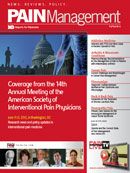Publication
Article
Pain Management
New Developments in Spinal Cord Stimulators and Low Back Pain Treatment Presented at ASIPP 2012
These studies were among those selected for special recognition at the 2012 annual meeting of the American Society of Interventional Pain Physicians (ASIPP).
These studies were among those selected for special recognition at the 2012 annual meeting of the American Society of Interventional Pain Physicians (ASIPP).
Researchers Identify Potential New Approach to Treating Lumbar Facet Instability
Noting that lumbar facet instability is a common source of chronic low back pain, and that there is a lack of consensus on current surgical options for treatment when conservative management of this condition fails to produce adequate relief, Wahezi, Algra, Kim, et al. from the department of Physical Medicine & Rehabilitation at Montfiore Medical Center proposed that a novel, minimally invasive treatment, whereby the facet joint is filled with medical bone cement to produce joint arthrodesis, is technically feasible and may offer a new treatment option for select patients in who are refractory to current treatment approaches. Using intact veal cadaver spines, investigators identified non-distractible (less than 0.5mm) and moderately distractible (0.5-1.0 mm) joints that had “no visible signs of facet capsule tears or facet joint fractures” and, using fluoroscopy-guided injection, filled the zygapophyseal joint with medical bone cement. After allowing the cement to harden, the researchers used manual traction to confirm joint arthrodecis; they reported that “three-dimensional mobility of the spine segments was significantly restricted compared to pre-injection mobility.” They used fluoroscopy to “confirm equal and complete filling of these joints.” They also used heat treatment to remove all soft tissue from the spine joints, leaving only the bone and bone cement, to confirm articular surfacing and capsular filling. They reported that arthrodesis was “only successful in all moderately distractible joints.”
Although these are only preliminary findings using an animal model, and “the role of this treatment is not known in humans and the reproducibility and safety in living subjects is not yet established,” the authors state that this approach for performing a percutaneous mobile arthrodesis of the facet joint is technically feasible and, after further study, “may guide future interventional pain management of unstable degenerative facet arthropathy.”
Neurostimulator that Automatically Adjusts Settings Based on Body Position Improves Convenience and Pain Relief
Studies have shown that patients with implantable neurostimulators can experience discomfort and variation in intensity of neurostimulation when they sit or lie down, often resulting in patients manually adjusting the stimulation settings on their device to less than optimal settings. Schultz, Webster, Kosek, et al. conducted a prospective, open-label study in which patients who had been implanted with the Medtronic RestoreSensor neurostimulator were randomized to receive either “position-adaptive stimulation” or manual programming adjustment for six weeks. Patients were then switched to the other treatment arm for an additional six weeks. The researchers assessed patients for improvement in pain relief and convenience and compared the scores for with the automatic position-adaptive stimulation option with manual adjustment alone. They reported that more than 85% of patients achieved “improved pain relief with no loss of convenience or improved convenience with no loss of pain relief when using automatic position-adaptive stimulation,” with no difference in adverse events between treatment arms. The authors wrote that “this study demonstrated that automatic position-adaptive stimulation is safe and effective in providing benefits in terms of patient-reported improved pain relief and convenience compared with manual programming adjustment alone.”
